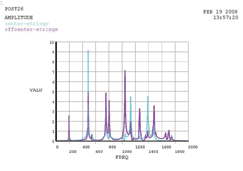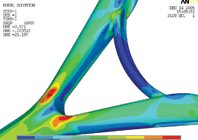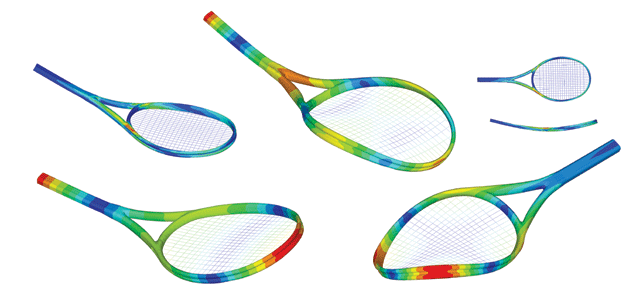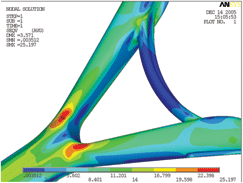The highly competitive tennis equipment market is characterised by an extreme emphasis on performance and very short product cycles. Austrian company Head Sport has succeeded in this market through a process of continual innovation, for which it uses advanced simulation technology to make ever–increasing performance improvements.

Analysis of tennis racket in various modes
In the past, Head engineers used the trial–and–error method to improve racket design but were constrained by the amount of time required to build and test each prototype as well as the limited information yielded by physical testing.
More recently, Head has made substantial performance improvements and accelerated the pace of innovation by using Ansys simulation technology to evaluate virtual prototypes in far less time than was previously required. The result is innovative designs that help world–class athletes win, such as the Youtek IG Speed MP 18/20 racket used by Novak Djokovic to win three Grand Slam tournaments in 2011.
Meeting Challenges
One of the basic challenges of tennis racket design is creating a frame that weighs only a few hundred grams yet can resist the tension force of 200 Newtons on each of its 76 holes, for a total force of 15,200 Newtons, or 3,417 pounds – the weight of a large automobile.
Head developers have addressed this challenge by using carbon and glass-fibre reinforced polymer (FRP) materials with specially engineered orthotropic properties that provide the stiffness needed for racket performance and the strength required for durability. Furthermore, a top-level player generates a serve speed velocity of 250 kilometres per hour, producing a peak force of 600 Newtons applied perpendicular to the strings for a period of three or four milliseconds.
During this period, the ball accelerates from 0 to 250 kilometres per hour. Head engineers use dynamic analysis to simulate this impact by applying the force of the ball to the strings in the form of a force-time function. In some cases, they simplify the calculation by converting the dynamic force to a static force.
One of the problems with previous racket design methods was that when a prototype racket passed a stiffness test, engineers never knew how close it came to collapsing. Using Ansys Mechanical, Head engineers can determine the stress on each individual layer of the composite laminate to a high level of precision and add or subtract small amounts of material to provide exactly the strength needed without any wasted material.
The result is that, today, Head can build a frame weighing only 200 grams that withstands both string tension and ball impact forces. In reality, a 200 gram racket is too light for playing tennis, but it gives engineers freedom to add other features to the racket.
Modal Shapes and Frequencies
Modal shapes and frequencies are becoming increasingly important in racket design because the way a racket “feels” is passed to the hand via vibrations. For example, a professional tennis player once came to Head and said he was unhappy with a racket that had been built specially for him but could not explain why. Head engineers used Ansys Structural to evaluate the modal shapes and frequencies of the racket and made changes to give it just the right feel.

Harmonic analysis
Over time, researchers have identified specific modal shapes and frequencies that provide a solid feel and stable racket, so they can address the feel of the racket from the beginning of the design process.
It’s also important to ensure that the proposed racket design does not have any modal harmonics that might be excited during normal use. For example, the first mode of vibration of the racket strings is typically around 500 Hz. Engineers analyse modal harmonics of proposed racket designs with Ansys software to be sure that higher modes are not too close to this number.
Higher modes play an important role in the sound generated by the racket. Head engineers optimise the mode shapes and frequencies to produce a sound that will provide the right feedback to the player.
Design Optimisation
When Head engineers first began using simulation, they evaluated a single design iteration, made changes based on the results, and ran a new simulation. It took approximately one week to evaluate the performance of each iteration.
Today, they frequently use a nonlinear optimiser with a genetic algorithm to generate design iterations then run Ansys Mechanical simulations automatically in a batch process to identify the optimal solution. The typical goal is to find the lightest structure with the highest stiffness and strength that meets other design constraints.
Recently, engineers used optimisation to evaluate one million design concepts in about a week to improve the design of a composite structure. The ability to analyse such a large number of design alternatives made it possible to optimise performance to a level that would never have been possible in the past. The optimiser frequently identifies design concepts that are such a departure from traditional engineering practices that the team would never have thought them applicable.
Head has developed a challenging series of quality tests that measure stiffness and strength, which every racket must pass before entering the market. For example, the racket must withstand a drop test onto concrete without any damage.
The team at Head has developed a series of Ansys Parametric Design Language (APDL) scripts that automatically simulate each test on a new design. The scripts import the CAD model of the racket, generate an FE mesh, orient the mesh, perform the five tests, and generate a report that provides detailed results. These scripts enable engineers to quickly and easily evaluate each proposed design from a quality standpoint, all from the early stages of the product development process.
Simulation has played a significant role in the improvements that Head has achieved in the performance and durability of its tennis rackets over the past decade. The detailed and accurate design information provided by Ansys Mechanical combined with the experience of Head engineers has made it possible to produce extremely lightweight designs that can withstand the enormous forces generated by string tension as well as the impact of the ball on the racket during the serve.
Engineers also use Ansys Mechanical to tailor other performance characteristics, such as the vibration and sound generated by its rackets. The results can be seen in the performance of Head rackets in the hands of players such as Djokovic, who after a remarkable series of victories over the world’s top players is widely considered to be one of the greatest tennis players of all time.
www.Head.com
www.Ansys.com

Stress analysis with Ansys Mechanical gives racket manufacturer the winning edge
Default








